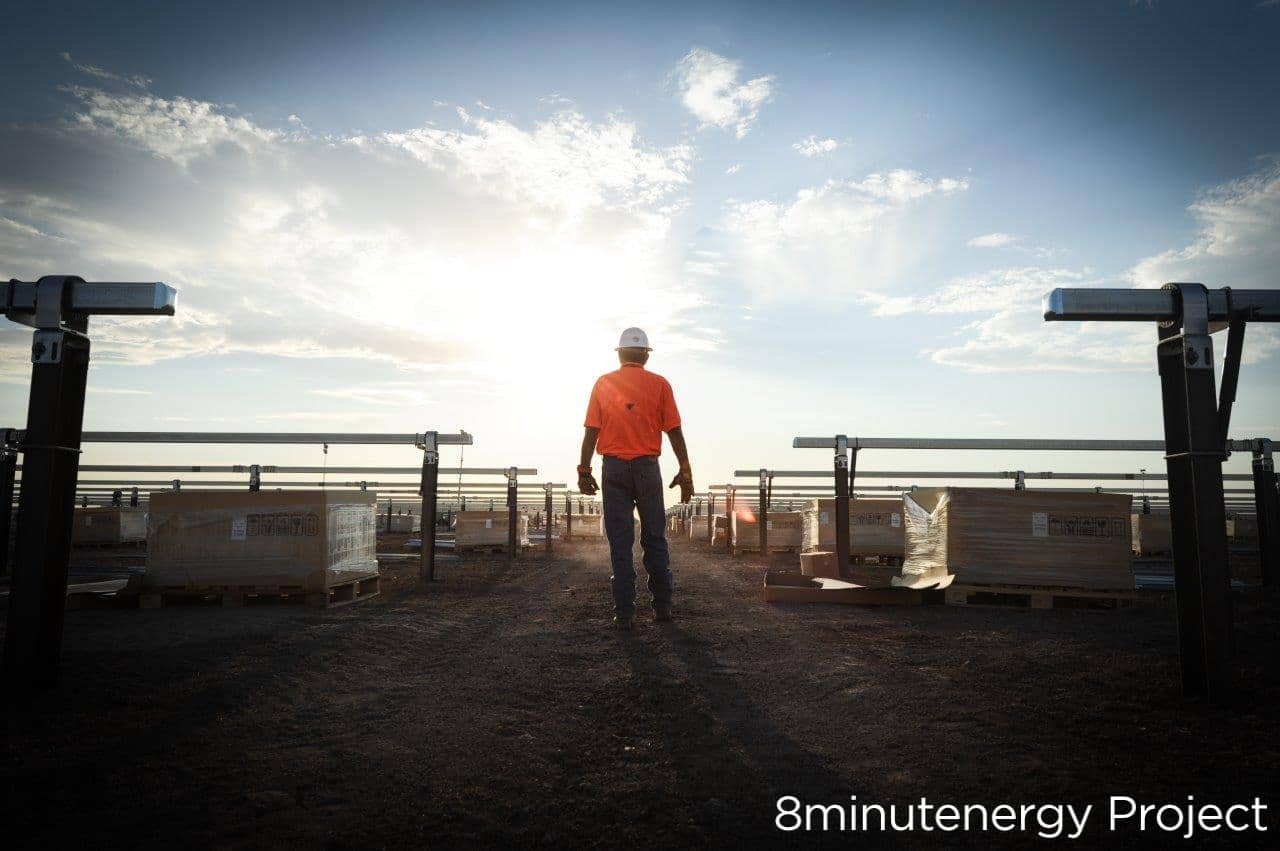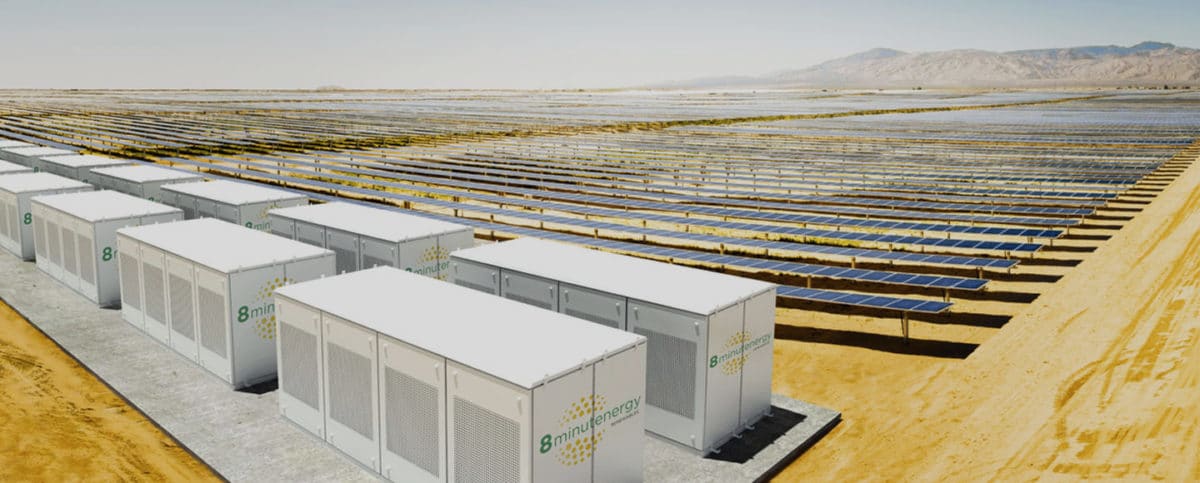When you’re the music maker, you have to do things no one has done before. Its your job. The CEO of 8minutenergy – Tom Buttgenbach, took time recently to answer questions from pv magazine, and of course, to talk about aliens.
Tom has a dual-PhDd from CalTech, built instrumentation for radio telescopes, worked as a business consultant, spent time in real estate development, and then in 2008 founded 8minutenergy along with Martin Hermann. In December of 2018, Tom took over the position of CEO and President, while concurrently receiving a $200 million in capital commitment from JP Morgan Chase to develop the company’s 10.7 GW portfolio of solar+storage projects.
And two questions that make some of us stay up and dream at night, were answered in a most spectacular manner:
“Will we see solar+storage with long term (~16-18 hours) storage onsite?”
Yes, the question is when – but in the next five years. And they’re in our pipeline right now. We’re designing them.
“Will these plants have heavily oversized (3x-4x-5x-6x) DC to AC ratios?“
Yes, they will have heavily oversized ratios.
With that, we can all go home, put our feet up, drink that scotch – think about redoing our resumes – and get back to work on the energy transition. As an aside, there are plenty of others thinking these ways.

Tom’s PhD thesis, Quasi-optical sis receivers and astrophysical observations at submillimeter wavelengths, included a chapter talking about the first discovery of neutral carbon (a fundamental building block of life) outside of our own Milky Way galaxy. And being the lover of space that I am, it of course led to the question of whether Tom thinks there is life out there?
In my mind, there is no doubt that life has formed in other areas, and every time I whack the weeds I realize it’s hard to kill life.
Whether that life has visited is a much more challenging idea of course – but at least we know Tom is thinking long term, about a galaxy far, far away.
The company has expanded its project pipeline from 10.7 GW to 14 GW+ of solar power since its December announcements. Additionally, there are “several” GWh of energy storage in that pipeline as well. The development is focused on the Southwest, California, Texas and a bit of the Southeast.

Tom’s opening words to pv magazine USA included that energy storage is no longer a cool feature, but something that our grid will increasingly depend upon as renewable penetration continues to increase.
A battery isn’t an add-on, but an integral part of the power plant. Designing the two together as one unit provides a reliable dispatchable power source for the grid.
“How long until we see a solar power plant + storage truly replace a full on gas power plant (not a peaker)?“
Signing a PPA (power purchase agreement) and a plant starting toward operation, I think you’ll see that in the next 12 months. It’s happening. Those plants will be built before the expiration of the ITC (investment tax credit) in 2023. I wouldn’t necessarily say, “We got this PPA and we’re going to shut this gas plant down.” There are sunk costs involved. However, you might not see any new gas plants being built – like happened in Los Angeles. The plan was to replace gas with a new plant, but that didn’t happen.
These (fossil plant) days are over, they’re all on death row. In Texas, they’re not going into Texas with new gas generation anymore. PJM, yes, because solar isn’t as competitive. But in the South, with sunshine and land, it’s hard to justify a new gas plant.
“Pricing decreases have slowed for solar PPAs. Do you expect to see lower $/kWh coming from solar PPAs? Is there a reason to keep going cheaper?”
On the solar only side, indeed the pricing decline has been slowing down. However, I cannot say it is low enough and I can kick back and relax. It’s not that we can set the prices, we’re always in a competitive situation and I’m still forced to drive costs down and heavily compete.
In the past, every time a solar panel got cheaper, my PPA went down in price. It was roughly a 1-to-1 correlation. That is no longer true, however. Today the solar panel is quite a bit less than half my power plant, the rest is land, trackers, cable and copper prices, land costs, interconnection, substations, transformers and labor. Labor and all of these technologies are conventional, and many of their costs have gone up.
There is no low hanging fruit anymore. Plenty of substations had space, that’s not true today. Today you have to accept quite a bit higher costs in order to interconnect to the grid. It’s very hard to find good, and inexpensive land close to those substations. However, we still have technology costs coming down, and that’s why you’ve seen a flattening.
Now storage is another story, it is at an earlier stage. Probably where solar was in 2013-2014. The combination of solar+storage is where you’re going to see more cost declines.

“Is lithium-ion still the main storage solution? Are you folks considering any flow battery solutions? Is there a logic for a site with some flow and some lithium ion?”
A lot of this is driven by the automotive industry, and lithium-ion is a good battery, no question. There are different flavors of lithium ion, and something I think is interesting: Electric cars only need like 500 cycles. However, I think there will be less and less cars that drive more, which will drive the requirements for cycles up. Which is important for us in the energy industry because we need a lot of cycles. And our industry will become large enough where batteries are made just for our industry, versus the automotive industry.
Flow batteries make a lot of sense, but there are no competitive offers just yet. You can offer up a chicken and egg problem, as they’ve not been able to scale yet. We are technology agnostic, but we’re very technology savvy also – we’ll take whatever makes sense depending on the use case, the cost numbers and then we’ll build our power plants around that.
For instance, zinc air batteries are interesting: They don’t need cooling, but they have a very low round trip efficiency. In my mind, it’s not that there are better batteries, but what the use case situation is. If there is curtailed electricity, then it makes sense to use these batteries in certain places.
However, these new chemistries aren’t financeable yet. We do love working with companies to get to finance-ability faster, if it is an interesting technology. But you cannot build a $200 million power plant with a physics experiment.
“How do you feel about merchant pricing risks in places like Texas? Are you signing PPAs to protect yourselves?”
We do both PPA and merchant pricing in Texas. Importantly, the marginal price is driven by gas, and I think that will continue. We recently saw 4 GW of coal retire, adding to that 3% organic growth in electricity usage, we see 4-6 GW that need be replaced. And folks aren’t building combined cycle gas because they know they can’t compete against solar+storage pricing in five to ten years. With that, gas will still be the marginal price setter when the load is higher – during the day, and will do so for quite a long while.
That’s why I don’t think the merchant risk in Texas will be high for ten years out. The forward pricing curve looks positive for us.
“It would seem that when a state, like say New Mexico with its pending new 100% regulation, puts forth a full on clean energy transition – folks like yourselves who focus on large utility scale projects would have a better opportunity. Is this the case?”
Yes, definitely – however – if you look at the Nevada PPA price, at $23.76/MWh, that’s half the price of gas. For a utility to look at that, and run the numbers, they don’t need regulation to tell them what to do. Look at Texas. It’s purely based on price.
In New Mexico, it is great to see that sense of urgency – getting a little push from behind helps. But a lot of folks are looking at the numbers all their own and saying, can you really do this?
“When do you think the “last” new gas plant will be built?”
It’s not the cost, it’s the long distance transmission. No one grows bananas in Michigan, but you can still drive them there. Why do we not bring the power from Texas and Arizona? It’s fiefdoms and monopolistic utilities.
If we look at the new DC technology, you can transport power from Utah to Los Angles with a 1% loss. However, building in low-sun areas sets you back a factor of 2-3 times. This is a political, not a technology challenge.
pv magazine USA, and this small time developer, appreciate the time spent with 8minutenergy, but more than anything, we value the team put together within groups like this who have the resources, the time, and the vision to develop ideas out far beyond what the sales teams of today get a chance to deploy.
Making the music means taking the risks. And right now we – the species – need risk takers looking deep into space.
This content is protected by copyright and may not be reused. If you want to cooperate with us and would like to reuse some of our content, please contact: editors@pv-magazine.com.








“If we look at the new DC technology, you can transport power from Utah to Los Angles with a 1% loss. However, building in low-sun areas sets you back a factor of 2-3 times. This is a political, not a technology challenge.”
Low sun areas are close to the best wind areas. DC transmission could easily power the entire midwest from wind/solar/storage facilities.
Hello James Linley: Can you please inform me of which company has the “new DC technology”?
“heavily oversized (3x-4x-5x-6x) DC to AC ratios”
– John, I am curious what oversizing the DC to AC ratio does for you. Hopefully you can help my understanding.
thanks.
(Good interview. I love that solar+storage is starting to eat NG.)
If you build a solar plant, and it is the standard 1.3:1, then that plant will produce a capacity factor of about 15-20%. It’ll produce enough electricity to meet the inverter size, the interconnection size, for a few hours (10 am till 2 pm if we’re lucky).
However, the day is 24 hours long. To do that, you need to produce enough electricity to match a consistent 24 hour usage volume.
So, let’s say your interconnection is 100 MWac. A 130 MWdc solar power project will produce enough electricity to full fill up that connection about 27% of the time (capacity factor). However, the world runs 24 hours.
So, a solar power project that is 100 MWac, but 450 MWdc – a 4.5:1 oversize – will produce 100 MWac of electricity for 22 hours. However, that excess electricity obviously need be stored to be delivered af night once the sun stops shining – thus storage.
I did the math here: Oversize (google docs)
There are other inefficiencies in this equation that I didn’t fully account for, but this is close enough for this conversation.
Me, being a pie in the sky type of solar advocate, really enjoyed hearing this feet-on-the-ground, dollars and cents, guy talk. Just the facts, ma’am.
These battery storage systems really should be put underground where the temperatures can be maintained at a better average (not to hot, not to cold) using a minimum amount of energy.
John, Thanks for this article; I can’t get enough info about inverter loading ratios and capacity factors. In the spreadsheet you shared in your answer to commenter John, you multiplied the MWdc times “1.8” to get GWh per year. Where did you get the 1.8? And wouldn’t it be a variable based on solar resource quality and whether or not tracking was used? I could really use the calculation you used this for but I would need to understand it. Thanks in advance for a some help.
It is an approximation for a place with 1800 kWh/kWp as power production
Interesting